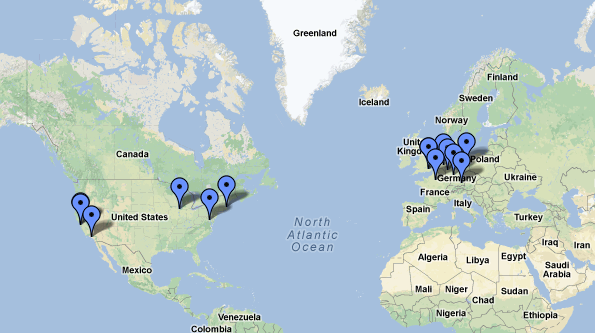Neo4j Tutorials – Around the World with Cypher

Community Manager
3 min read

Hey all, We have a special blog post written by our wonderful Neo4j community contributor Peter Bell. He has presented Neo4j in many settings, including recently at our Neo4j Tutorial – NYC. Below are his reflections on the seminar and Neo4j:
I’ve always been excited by the capacity of graph databases to provide deeper insights into data, but when the Neo Technology team asked me to work with them to create a one day training class I was surprised by just how far the project has come over the last few months.
Not that long ago, you needed to be a Java programmer with a perverse love of writing “traversal descriptions” to take advantage of the power of Neo4j. Now with Cypher, after only a short learning period you can write simple, declarative queries to traverse your graphs and gain more insight into your data.
At first, Cypher looks weird; it’s as if a cartoonist decided to describe graphs using ASCII-art. But once you get over the logical but unusual syntax, it’s an incredibly powerful way to work with graphs. It allows you to write short, declarative descriptions of what you want to retrieve from the graph. Cypher is like SQL for graphs, and if you haven’t played with it yet, you should definitely learn the basics.
It never used to be hard to figure out the use cases for a graph database, but now more companies have started to solve real world problems, including recommendation systems, route planning, access control and bioinfomatics. We’re getting more and more case studies everyday showing just how widely applicable graph databases can be.
The class itself was a lot of fun. There were developers with a wide range of backgrounds from C++ to PHP, Ruby, Python and Java – luckily you don’t need to be a Java programmer any more to work with Neo4j! We started off with a brief introduction to graph databases and the rise of their importance in projects like Facebook’s new Graph search and Google and Twitter’s graph-based initiatives. We then looked at some of the common data modeling issues people run into when trying to first model data using a graph and after we covered those high points, we looked at importing data.
After lunch, most of the afternoon was spent learning Cypher hands-on to show how easy it is to create, modify and query graphs using Cypher’s syntax. Once we were done with the materials it was time for questions and we were able to cover a wide range of common questions that we’ll be building into the next version of the tutorial.
The goal of this one-day tutorial was to take people with some interest in graph databases to the point where they would be comfortable building a non-mission critical app using Neo4j. Happily, by the end of the day, everyone felt confident that they were in a position to go build an app using neo4j.
If you’d also like to learn how to really get started with Neo4j, you should check out GraphAcademy.
Thanks Peter for the kind words! We’re coordinating more Neo4j Tutorials all around the world; to find a tutorial near you, check out our events page.
Cheers, Adam











